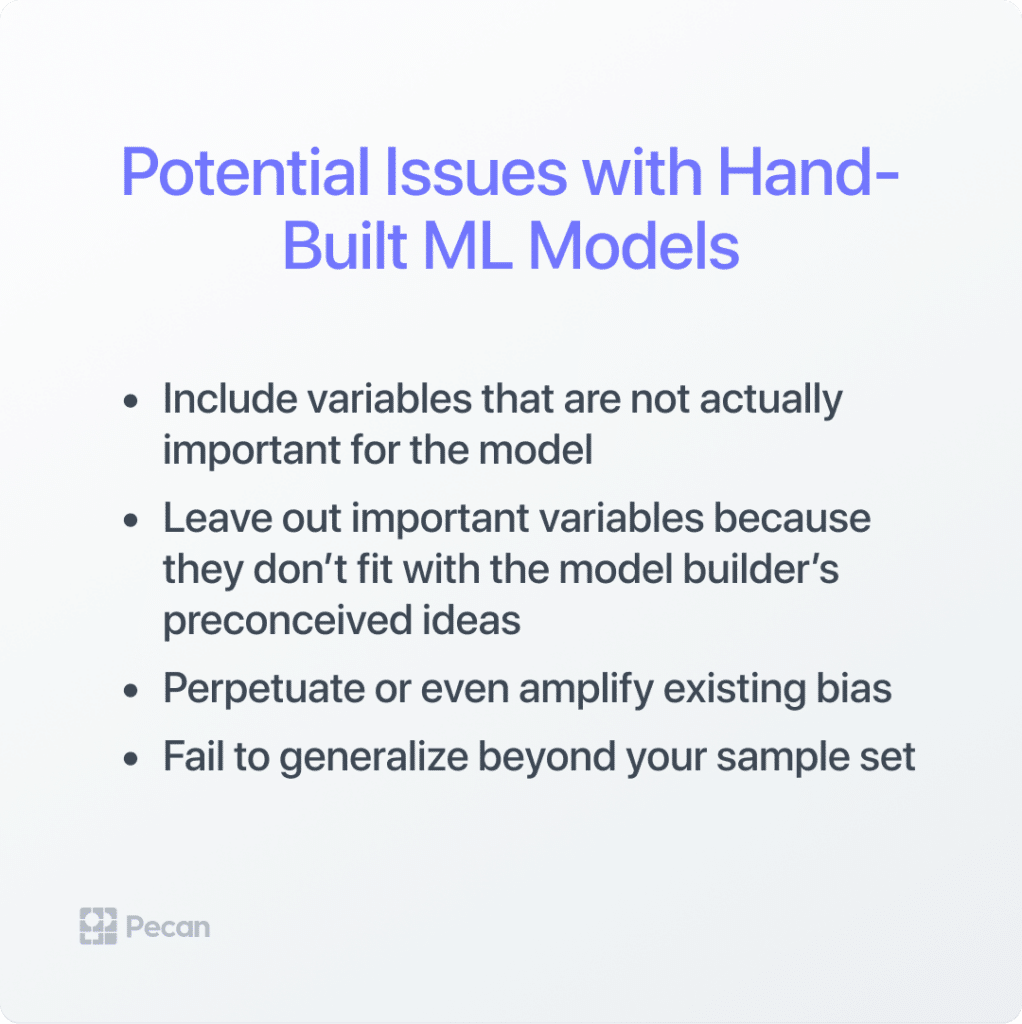In a nutshell:
- Data analysts often face issues with limited value of historical insights and unused insights.
- Data goes unused due to limited capacity to process and analyze it.
- Bias is unavoidable in traditional predictive modeling.
- Long time to value and data-security concerns are common problems.
- Predictive analytics platforms can overcome these issues by providing accurate predictions, easy integration, and automated processes.
As a data analyst, your job is to make sense of data by breaking it down into manageable parts, processing it, and performing statistical analyses that reveal trends, patterns, and relationships. And you typically need to present those insights in a way that’s easy for stakeholders to understand.
This process is crucial for organizations that are looking for a data-driven way to make informed decisions, improve business outcomes, and gain a competitive advantage. And thanks to the emergence of new tools, technologies, and techniques, the realm of what’s possible is constantly expanding. Indeed, with the advent of AI, data analytics has become more powerful and efficient than ever before.
However, like many analysts, you may be grappling with some all-too-familiar issues that prevent analysts from doing their best work and making a significant business impact.
In this article, we’ll explore seven common issues faced by data analysts, and how using predictive analytics can be a great way to overcome them.
Problem 1: Limited value of historical insights
The most common application of data analysis is descriptive analytics, where historical data is analyzed in order to understand past trends and events.
The problem? Relying solely on historical insights has limited value, especially in fast-changing businesses where consumer behavior and preferences, as well as market conditions, are constantly evolving. By definition, such insights are based on past trends and events, which may not apply to current or future scenarios and can lead to inaccurate or incomplete analyses.
Relying only on past data can also create bias towards the status quo, which limits your ability to identify new opportunities and potential risks. Take the example of a retailer that relies solely on historical data to determine which products to stock: they’re likely to miss out on new trends or shifts in customer preferences, which leads to missed sales opportunities.
To address this problem, you should strive to complement historical insights with predictive analytics. With this approach, you can identify emerging trends and quickly adapt to changing market conditions.
And by leveraging machine learning within a predictive analytics platform, you can identify meaningful patterns that would otherwise be undetectable. This leads to highly accurate predictions that your business can take advantage of in order to make proactive, well-informed decisions.
-

- Image by Airfocus on Unsplash
Problem 2: Insights aren’t utilized
No one loves the idea of toiling away for months or years, only to discover that their work has been overlooked, undervalued, or not put into practice.
Unfortunately, statistical insights are often viewed as unusable, or even meaningless, if stakeholders can’t easily identify and take relevant action. As mentioned above, this is often the case with descriptive analytics, where there is a focus on the past rather than the future. And as a result, analysts often invest lots of energy into preparing dashboards and reports that are rarely ever used or incorporated into the business workflow.
One way to overcome this challenge is by using a predictive analytics platform that allows you to choose from a variety of pre-built models that can be customized to fit specific use cases. This way, you can easily generate actionable predictions that serve a particular goal, and also enjoy the benefit of automatically generated, easy-to-use dashboards.
In addition, predictions can be integrated directly into your existing work tools. For example: if your goal is to reduce customer churn, you can integrate churn predictions alongside your existing CRM data. This would allow your colleagues to strategize something like an email campaign built on segments reflecting how likely each customer is to churn.
The best way to ensure all your hard work is put to use is by generating insights that can truly guide business decisions and help your company achieve mission-critical KPIs.
Problem 3: Data goes unused
Businesses collect and generate massive amounts of data. But even when they have sufficient resources, they’re not able to use much of this data due to humans’ limited capacity to think about and process data. In many cases, analysts aren’t even sure of whether particular data is worth using due to data quality issues or questions about its meaning.
For these reasons and more, data professionals are generally only able to build a small number of rule-based models, which can only account for two or three variables at a time.
This common challenge can be overcome with a predictive analytics platform like Pecan. By leveraging automated machine learning to analyze vast amounts of data, you can slash the time and effort it takes to decide which data is relevant. Here’s what we mean…
You can instantly feed raw data into a predictive model, and this data can come from any source (such as sales data, user engagement data, customer demographics, and social media). And automating this process means you can use updated data to generate fresh predictions regularly, helping you stay on top of changing customer behavior and market conditions.
The platform will then automatically determine which data is relevant (through behind-the-scenes processes like feature selection and feature engineering), and then will find the best predictive model that can be built using that data.These automated processes enable you to analyze massive datasets and generate accurate predictions within a matter of hours, instead of months. This means you can focus on communicating and creating real value out of your insights, without doing all the heavy lifting.
-

- There are important issues to consider with even custom, hand-built models.
Hand-built models might seem like the ideal solution to data problems, but they can introduce their own issues.
Problem 4: Bias is unavoidable
Traditional predictive modeling involves the use of statistical and mathematical techniques to uncover relationships and identify trends. But as scientific as it may be, there is always human bias in the process of selecting variables.
This means that hand-built models will inevitably, at some point:
- Include variables that are not actually important for the model (but possibly correlate with the outcome)
- Leave out important variables because they don’t fit with the model builder’s preconceived ideas
- Perpetuate or even amplify existing bias (e.g., by restricting your model to a certain gender or zip code)
- Fail to generalize beyond your sample set (e.g., if the model is based on data from a limited time period)
This bias doesn’t happen when you use a predictive analytics platform. One key reason is because automated feature engineering will evaluate and construct thousands of potential variables that could be used in your model, and then determine which are most relevant. (Naturally, this multi-variable approach also leads to more accurate and reliable predictions.)
In the case of Pecan, a simple dashboard will reveal how your model arrived at its predictions, by showing the degree to which each variable (a.k.a. feature) influenced its outcomes. This knowledge also enables you to identify and mitigate any potential biases that may be introduced through your raw data itself.
Problem 5: Long time to value
To be implemented and adopted, many analytics tools require significant change management and engineering assistance. And, of course, analytics projects themselves demand a significant amount of time and resources. Sometimes they will bear fruit, and other times they won’t.
Contrast that with a predictive analytics platform, which can do in hours what it might take a data analyst or scientist months to achieve. Not only can you connect multiple data sources to the platform for automatic importing, but with Pecan, you can use Predictive GenAI to define a predictive question that can be answered with a model based on your raw data. Auto-generated code kickstarts your model, which the Pecan engine then automatically builds. The model uses hidden patterns in your data to generate predictions. With those predictions, your business colleagues will be able to act quickly on the provided insights to achieve their business goals.
Another thing to keep in mind: data changes over time, and models require ongoing maintenance in order to remain accurate and effective. In the case of traditional rule-based models, this often means restarting the modeling process from scratch.
But with an automated approach, a predictive model only needs to be built once. With automated model-retraining and monitoring capabilities, all you need to do is feed it new data and/or adjust the variables you wish to use in your predictions.
-

- The time required for automated predictive analytics is far less than with traditional data science initiatives
The time required to resolve data problems with an automated platform can be far less than preparing data by hand for modeling.
Problem 6: Data-security concerns
Technical difficulties aside, concerns and regulations around data security can make it extremely challenging to integrate different data tools and achieve smooth adoption.
According to a 2020 report by IBM, the average cost of a data breach is $3.86 million. Navigating security best practices and avoiding potential security issues is a lot to ask of a data analyst who is not a security professional yet is tasked with managing and integrating sensitive data across multiple tools, whether locally or in the cloud.
This is where an all-in-one predictive analytics platform again proves advantageous. For example, Pecan prioritizes data security and takes various measures to ensure sensitive information is protected at all times. Let an enterprise-grade solution take care of the security business—so you can focus on yours.
Problem 7: Tedious, time-consuming processes
If we haven’t made it clear by this point, turning raw data into actionable insights is no small feat. And we’d be remiss not to spend some time talking about the person at the center of all this: the data analyst.
In data analytics projects, manual processes add multiple layers of complexity, difficulty, and stress. Analysts often need to carry out tedious and/or time-consuming tasks like data collection, data cleaning, data transformation, data visualization, and, of course, statistical analysis itself. Add a variety of tools and techniques—from programming languages like Python or R to data-visualization tools like Tableau or Power BI to statistical software like SPSS or SAS—and an analyst’s work is cut out for them.
Furthermore, incomplete, inconsistent, inaccurate, or outdated data can significantly impact the effectiveness of a statistical model. So when you add issues of data quality to an already heavy load, fulfilling a data analytics project can seem like an insurmountable feat.
Fortunately, predictive analytics platforms can handle all of the most tedious and complex processes. For example, Pecan automatically performs tasks like data prep, feature engineering, model tuning, and model deployment and monitoring. It can also identify and remove incomplete or inaccurate data and automatically transform your data into the right format for training accurate machine learning models.
What this means is that data analysts, instead of being weighed down by outdated data practices, can focus on building business use cases and imagining how their predictive insights can help solve real business needs.
Wrapping up
An honest assessment of the “old way” of doing things will lead to one obvious conclusion: It’s time to update the way your team performs data analytics. You and your organization should aim for a more holistic approach that maximizes the value of your data. You can gain a complete understanding of your customers and business processes, and make more informed (and profitable) decisions.
Predictive analytics platforms are a great solution for overcoming many of the pain points that plague data analysts. By leveraging machine learning algorithms and automated ML processes, you can quickly analyze huge volumes of data, generate accurate predictions that target a specific business need, and help your business make better decisions that keep you ahead of the competition.
Ready to see how easy it can be to use predictive analytics to supercharge your data analytics role and solve your data problems? Sign up for a free trial now and try it yourself!






